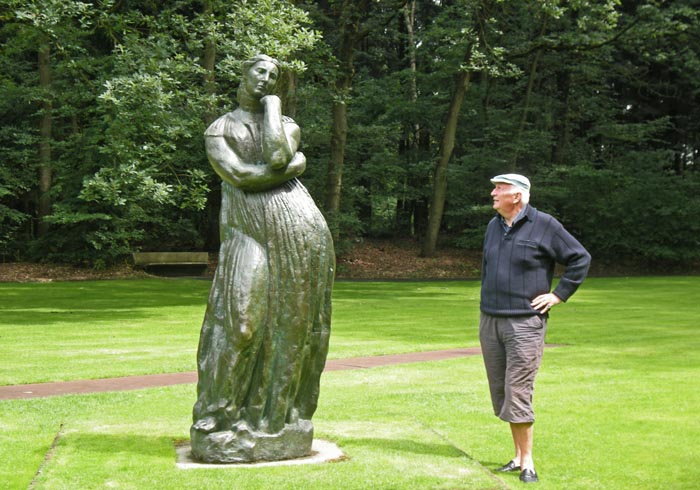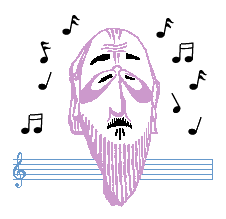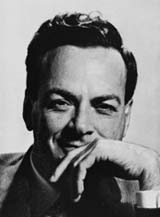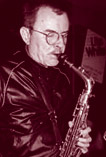|
Biographical Log of Michael Furstner - Page 62
2008 ||
2009 :
Jan |
Feb |
Mar |
Apr |
May |
Jun |
Jul |
Aug |
Sep |
Oct |
Nov |
Dec | Page :
Previous |
Next |
Most Recent -
Next -
Previous -
Page 1 -
Photos -
Index -
Topics -
MP3s -
Jazclass Links
Tuesday January 6, 2009
(diary)
 It is a beautiful day today, blue sky with only a few scattered clouds,
sunshine, warmth. The sea is clear and sparkling with big dumper waves
that rush cascades of white foamy water towards the beach. I splash around
in it and feel much refreshed as I get out.
It is a beautiful day today, blue sky with only a few scattered clouds,
sunshine, warmth. The sea is clear and sparkling with big dumper waves
that rush cascades of white foamy water towards the beach. I splash around
in it and feel much refreshed as I get out.
At the Surf Club I watch
the Sydney cricket test, now in its 4th day with the Aussies steadily gaining a clear
advantage. Will they manage to win this one ? Tomorrow will be an exiting
final day.
Back home I make a few more recordings on my keyboard, but
am not happy with them. Nushi (the new young dog at ThreePonds)
however has a wonderful time chewing on the recorder's power lead and I
am not impressed.
Thinking back about last year's cultural
events I suddenly realise that I actually did manage to go to six of
them during 2008. Five of them where museums or exhibitions I went to in
Europe (one in Cadaqués and four in Holland), plus the Cirque du
Soleil which makes six.
Strangely enough I always much prefer
exhibitions (especially of impressionist and modern artists) over
plays, concerts, ballets, etc. This is, I believe, a clear reflection of me
being very much a one to one person. At an exhibition you have a
one to one intellectual encounter with the creative mind of the artist at your own pace and
without the interference of anything or anyone.
 I am almost inclined to add the wonderful day I had
cruising through the Weerribben to my 2008 cultural events list. It
was an intimate embrace with nature which left a deep emotional
imprint on me equal to, if not stronger than, most cultural exposures.
This is not so surprising, ever since I was a young boy nature has
been the prominent, constant and most reliable guide throughout the
emotional and spiritual development of my life.
I am almost inclined to add the wonderful day I had
cruising through the Weerribben to my 2008 cultural events list. It
was an intimate embrace with nature which left a deep emotional
imprint on me equal to, if not stronger than, most cultural exposures.
This is not so surprising, ever since I was a young boy nature has
been the prominent, constant and most reliable guide throughout the
emotional and spiritual development of my life.
Most Recent -
Next -
Previous -
Top -
Page 1 -
Photos -
Index -
Topics -
MP3s -
Jazclass Links
Wednesday & Thursday January 7 & 8, 2009
(diary)
 Two pleasant days, warm and generally sunny. Wednesday the Australian cricket team manages to win the Sydney test match against South Africa with just 10 balls to spare.
Two pleasant days, warm and generally sunny. Wednesday the Australian cricket team manages to win the Sydney test match against South Africa with just 10 balls to spare.
Thursday morning I manage to record good retakes of two songs I was not quite happy with. Sometimes I become so focused on the improvisation line that I block out (don't "hear") the backing and as a result my timing goes off. I also explore Erik Satie's Gymnopedie Nr.1, perhaps his most famous composition. I need to play it several times to decide just in which format I am going to record it. It is a song in 3/4 (waltz) time, but often performed in 4/4. I too prefer this latter time pulse and will record it as such.
We are having extensive rains in the NT and outback Queensland, and some of the roads to Mount Isa are washed away. It will take at least 6 weeks to repair these, but it is good to have finally a good drenching of rain in those areas. In contrast Europe is having a cold winter and I am told that this year the traditional Elf stedentocht (ice skating race on Friesland's canals and lakes along 11 towns) is definitely on.
Most Recent -
Next -
Previous -
Top -
Page 1 -
Photos -
Index -
Topics -
MP3s -
Jazclass Links
Friday January 9, 2009
(diary, art, music, Picardi triad)
 When reading a book of say Thomas Hardy (the 19th Century English
novelist) we may easily overlook the fact that he was writing at the
cutting edge of the then prevailing social and moral issues and was
heavily scrutinised and censored by the authorities.
When reading a book of say Thomas Hardy (the 19th Century English
novelist) we may easily overlook the fact that he was writing at the
cutting edge of the then prevailing social and moral issues and was
heavily scrutinised and censored by the authorities.
With the French
composer Erik Satie
we are much less likely to make this mistake. Despite efforts of his good
friend and colleague Claude Debussy to get him accepted by Paris
society, Satie was very much anti-establishment (a sentiment I
share with him since my early childhood) and deliberately went out off his
way to annoy it by ignoring Centuries old musical customs and "rules". He
wrote his Gnossiennes
without inserting bar lines in the music, and when critics stated
that his music "had no form" he immediately wrote a "Composition in the shape of a Pear" and a "Composition in the shape of a Dog".
A much more subtle act against established rules I suddenly spotted when
working on his Gymnopédie
1 which I completed and uploaded online today. Let me
explain.
It has been a Centuries old point of view in traditional Classical music
that a minor chord was not really a suitable chord to end a piece
of music on, as it was considered to be slightly dissonant. To overcome this problem for
pieces in a minor key the appropriate truly
consonant major chord was used as the final ending chord. In music theory this is called a
Picardi triad (a triad is a 3-note chord like : C E G). There certainly is some merit to this old fashioned
musical notion. When a piece with a strong minor mood is ended on a
major chord (especially a major 7th chord) it is as if at the end
of a dark, gloomy overcast day suddenly the sun comes out, a very exhilarating and
joyful moment. This ploy has been used by several popular composers like
for example Victor Young in 'Stella by
Starlight', Cole Porter in 'What is
this Thing called Love' and others.
During Satie's time however (around 1900) the Picardi triad was still very much in
vogue as part of the old musical esthetics. Predictably Satie went
resolutely against this formal "rule", turning it back to front, notably
in his famous Gymnopédie
1 which he wrote in the key of D major and ended on a D
minor chord. I love you my friend.
|
The Picardi triad for musicians
The presence of minor chords in a melody does not mean that a song
is in a minor key. Far from it. Most songs in major keys do have minor
chords in their chord progression, simply because there are three minor
scaletone chords in any major scale.
In the C major scale (C D E F G A
B C) they are : Dmin7 (DFAC), Emin7 (EGBD)
and Amin7 (ACEG)
A typical major key sequence in C is :
Dmin7 (DFAC) - G7 (GBDF) - Cmaj7 (CEG)
IIm7 - V7 - Imaj7
Therefore in (Dmin7 - G7 - Cmaj) or in
(Gmin7 - C7 - Fmaj) the Cmaj and
Fmaj chords are not Picardi triads.
Chords in a truly minor key progression are constructed from the
harmonic minor scale.
In the key of C : C D Eb F G Ab B C.
The tell tale sign for a minor key chord progression are a half
diminished chord (ø) followed by a Dominant chord a 5th
down.
In the key of C minor :
Dø (DFAbC) - G7 (GBDF) - Cmin (CEbG)
IIø - V7 - Imin
Therefore in (Dø - G7 - Cmaj)
or in (Gø - C7 - Fmaj)
the Cmaj and Fmaj chords are Picardi triads.
|
Most Recent -
Next -
Previous -
Top -
Page 1 -
Photos -
Index -
Topics -
MP3s -
Jazclass Links
Saturday January 10, 2009
(diary, quantum mechanics, music)
It is Babette's birthday today. In the morning
two of her good friends, Naomi and Sandy visit, staying for
several hours, and in the evening I take her and Doug out for dinner at
the Thai Parnit Restaurant in Nambour. Both are also celebrating the fact that in the
past 12 weeks of dieting they each lost 10 kg of weight.
If you have listened to some of my online MP3 recordings you may have wondered
why I prefer fade outs for most of the songs rather than regular
endings. There are two reasons for that.
Firstly there are for
each style (bossa, ballad, jazz, etc.) two preprogrammed endings on my
electronic keyboard. They are quite good but of course may not always be
in character with the way I play a song. In fact in most cases they are
not.
 The second reason has a much deeper emotional and philosophical origin. I
only realised this a few days ago when, most surprisingly, I was reading
something in David Greene's 'The Fabric of
the Cosmos' (Chapter 7, page 180). It makes a most interesting
story I find. Here goes.
The second reason has a much deeper emotional and philosophical origin. I
only realised this a few days ago when, most surprisingly, I was reading
something in David Greene's 'The Fabric of
the Cosmos' (Chapter 7, page 180). It makes a most interesting
story I find. Here goes.
The Nobel laureate and brilliant 20th Century physicist Richard Feynman formulated a way of thinking
about the uncertainty in quantum
mechanics surrounding the properties and movements of the tiniest
building blocks of our universe, which appear to be both particles and
waves at the same time.
In his sum over histories principle Feynman states
that "if there are alternative ways in which a given
outcome can be achieved, then there is a sense in which the alternate
histories all happen, and happen simultaneously."
Let me explain what this means. Imagine I am standing at the very Southern
end of Mooloolaba beach, at the "Spit", the stone pier extending into the
sea (just to the left of the four high rise buildings on the
photo below).
I have had my swim, I am hungry and want to get back to the Surf
Club
(just to the right of the Life Savers watch tower in the right foreground
of the photo) for lunch.
There are four practical ways for me to get there :

- jump into the surf and swim back
- walk back along the beach
- take the walking trail through the dunes behind the beach
- or walk back on the main road farther inland
I decide to walk back along the beach and in due course arrive at the Surf
Club, no problem.
But what if a tiny electron or a photon
(light particle-wave) were to do the same thing ? Starting from the same
point at the Spit where I walked back from it travels to the Surf Club in
an instant (at the speed of light). But when it arrives it appears as if
it has got there by using all four alternative paths : the surf, the
beach, walking trail and main road (plus many other possible pathways) all at the same time *. Weird ? Tell
me about it ! But reality, as we are starting to discover now, is quite
amazing, and very different from what we have always believed it to be.
Back to music. Strangely enough I see a clear parallel between
Feynman's sum over histories and the creativity of Jazz
improvisation. A song generally consists of two components, a
melody line and an underlying succession of chords (a socalled "chord progression") which give the song colour and mood. The
melody and chords of course do not clash but are in harmony with one
another.
Some composers start by writing the melody first, then
construct an appropriate chord progression for it. Others (like me
mostly) start with formulating a chord progression and then create a melody
line over it. Whichever way it is created once a song exists it is its
chord progression which represents the fundamental essence
of the song.
 Over a song's chord progression we can create an
infinite number of other melodies, the only restraint being that a
melody should not clash but be in harmony with the chord progression.
This is exactly what the Jazz improvisor does. He creates an
instant new melody over the given chord sequence, within the constraints
of his musical knowledge and understanding, technical skills and creative
imagination. Every performer will have his own unique approach to a song
and over time, as his familiarity and emotional insight into the song
increases, his improvisations will improve in terms of meaning and
subtlety. Over a song's chord progression we can create an
infinite number of other melodies, the only restraint being that a
melody should not clash but be in harmony with the chord progression.
This is exactly what the Jazz improvisor does. He creates an
instant new melody over the given chord sequence, within the constraints
of his musical knowledge and understanding, technical skills and creative
imagination. Every performer will have his own unique approach to a song
and over time, as his familiarity and emotional insight into the song
increases, his improvisations will improve in terms of meaning and
subtlety.
One of my teachers, the brilliant and absolute world class Australian
saxophonist Barry Duggan told me once that it had taken him 10
years (!!) to come fully to grips with Duke Ellington's composition
Satin Doll. Revealing a glimpse of Barry's depth of insight and
emotional involvement in his music.
So like in Feynman's sum over histories principle, there are
numerous improvised melodic pathways from a song's beginning to its end.
But since we are no tiny electrons or photons but large clumsy human
beings we cannot perform all possible pathways at the same time. Instead
we must be content to play our improvised melodies one after the other.
But as there are an infinite number of possible improvisations over a
song, a song never ever really ends. That is why I much prefer to fade out
at the end creating for you, the listener, the illusion that the song
continues to go on, and that only I, the performer, gradually move away
into the distance and out of the range of your ears.
| *
| In a true life experiment the behavior of a wave-particle would of course be much more complex because of the various obstructions like trees, houses, etc. it would be blocked or deflected by on its various pathways, and because of the numerous other possible pathways a tiny wave-particle could travel to the Surf Club which a human body could not.
But my simplistic description gives you a good idea of the type of thing that is actually ocuring.
|
PS (15/8/09)
The nearest thing (in terms of musical performance) to the quantum sum over histories
theory is probably the group improvisation by Trad Jazz bands (we called
them "Dixieland bands" in Holland), where trumpet, trombone, clarinet, bas, drums, piano,
banjo each follow there own unique path through the chord progression of a song, while all
playing simultaneously.
Comments -
Most Recent -
Next Page -
Previous -
Top -
Page 1 -
Photos -
Index -
Topics -
Jazclass Links
Copyright © 2009 Michael Furstner
|




 The second reason has a much deeper emotional and philosophical origin. I
only realised this a few days ago when, most surprisingly, I was reading
something in David Greene's 'The Fabric of
the Cosmos' (Chapter 7, page 180). It makes a most interesting
story I find. Here goes.
The second reason has a much deeper emotional and philosophical origin. I
only realised this a few days ago when, most surprisingly, I was reading
something in David Greene's 'The Fabric of
the Cosmos' (Chapter 7, page 180). It makes a most interesting
story I find. Here goes.

 Over a song's chord progression we can create an
infinite number of other melodies, the only restraint being that a
melody should not clash but be in harmony with the chord progression.
This is exactly what the Jazz improvisor does. He creates an
instant new melody over the given chord sequence, within the constraints
of his musical knowledge and understanding, technical skills and creative
imagination. Every performer will have his own unique approach to a song
and over time, as his familiarity and emotional insight into the song
increases, his improvisations will improve in terms of meaning and
subtlety.
Over a song's chord progression we can create an
infinite number of other melodies, the only restraint being that a
melody should not clash but be in harmony with the chord progression.
This is exactly what the Jazz improvisor does. He creates an
instant new melody over the given chord sequence, within the constraints
of his musical knowledge and understanding, technical skills and creative
imagination. Every performer will have his own unique approach to a song
and over time, as his familiarity and emotional insight into the song
increases, his improvisations will improve in terms of meaning and
subtlety.